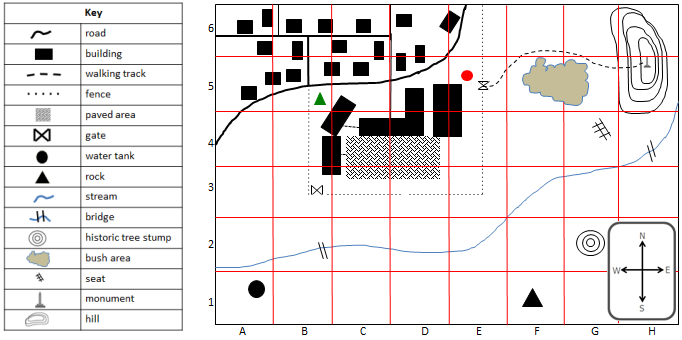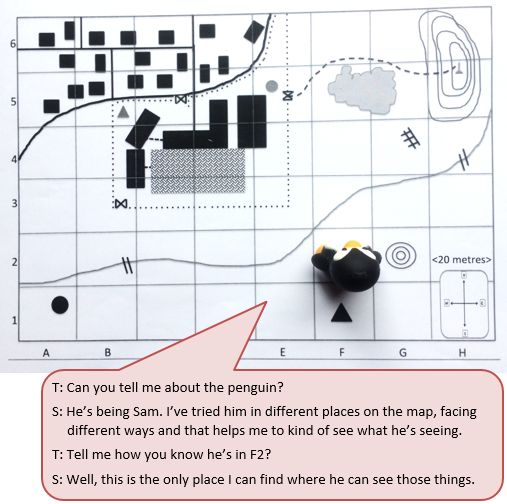The purpose of this activity is to engage students in accurately reading and interpreting a map of an unfamiliar location. They should be particularly aware of the significance of using landmarks to locate positions on the ground.
This activity assumes the students have experience in the following areas:
- Reading simple maps to locate and move.
- Interpreting grid references on maps.
- Drawing simple maps of familiar places.
- Using scale to estimate distances on maps.
The problem is sufficiently open ended to allow the students freedom of choice in their approach. It may be scaffolded with guidance that leads to a solution, and/or the students might be given the opportunity to solve the problem independently.
The example responses at the end of the resource give an indication of the kind of response to expect from students who approach the problem in particular ways.
From where Sam is standing, he can see the bush and track ahead of him in the distance, a tree stump on his right, and in the distance to the west, a small bridge over the stream.
- Where is Sam standing? If he makes a half turn, what will he see?
- Pretend you and two of your friends are in different places on this map.
Write what each of you can see to the north, to the east, to the south and to the west.
Have a classmate use your clues to work out where the three of you are.
The following prompts illustrate how this activity can be structured around the phases of the Mathematics Investigation Cycle.
Make sense
Introduce the problem. Allow students time to read it and discuss in pairs or small groups.
- Do I understand the information on the map? How do you know what each icon means? Can you find the compass? What do the letters and numbers represent?
- Do I know what the words mean? (The meaning of compass points (N,E,S,W) is important.)
- What will a correct answer look like? (The answer will be a grid reference of where Sam is located and another position puzzle for others to solve.)
Plan approach
Discuss ideas about how to solve the problem. Emphasise that, in the planning phase, you want students to say how they would solve the problem, not to actually solve it.
- What maths ideas are involved in the problem? (Discuss the features of maps such as compass directions, scale, and legend.)
- What do I already know about maps?
- If I already knew where Sam was, how would I describe his position? Choose a place and try.
- How might I use the map? How will I use the information? (Can students work backwards with the clues, e.g., If the stump is on Sam’s right, then he must be to the left of the stump.)
- What tools might be useful? (A small object to represent Sam might work for some students.)
- How will I know when I solve the problem?
Take action
Allow students time to work through their strategy and find a solution to the problem.
- Where might I begin? What information is the most useful?
- How will I use the information and work backwards to Sam’s location?
- How will I record what I find out from each piece of information in an organised way?
- Will my drawing on the map make sense to someone else?
- Can I learn from what others are doing?
- What will make a problem I create easier or harder?
Convince yourself and others
Allow students time to check their answers and then either have them pair share with other groups or ask for volunteers to share their solution with the class.
- What is my answer? Does my answer match all the information?
- How might I convince someone else that my location for Sam is correct?
- Could I have solved the problem in a more efficient way? How?
- What did I learn about interpreting maps?
- How might what I learned help me to make sense of a map about a different scene?
- What advice would I give others about how to solve my problem?
Examples of work
Work sample 1
The student uses a toy to represent Sam and tries different locations on the map to see if they match the description of views.
Click on the image to enlarge it. Click again to close.
Work sample 2
The student connects all the information from the map, including scale and direction, to locate Sam’s position.


